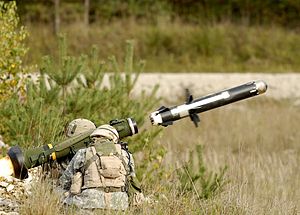
Back صاروخ موجه مضاد للدروع Arabic Tank əleyhinə idarəolunan raket Azerbaijani Супрацьтанкавы ракетны комплекс Byelorussian Противотанкова управляема ракета Bulgarian Míssil antitancs Catalan مووشەکی دژەتانک CKB Missili vidatu anticarri Corsican Protitanková řízená střela Czech Panzerabwehrlenkwaffe German Misil antitanque Spanish


An anti-tank guided missile (ATGM), anti-tank missile, anti-tank guided weapon (ATGW) or anti-armor guided weapon is a guided missile primarily designed to hit and destroy heavily armored military vehicles. ATGMs range in size from shoulder-launched weapons, which can be transported by a single soldier, to larger tripod-mounted weapons, which require a squad or team to transport and fire, to vehicle and aircraft mounted missile systems.
Earlier man-portable anti-tank weapons, like anti-tank rifles and magnetic anti-tank mines, generally had very short range, sometimes on the order of metres or tens of metres. Rocket-propelled high-explosive anti-tank (HEAT) systems appeared in World War II and extended range to the order of hundreds of metres, but accuracy was low and hitting targets at these ranges was largely a matter of luck. It was the combination of rocket propulsion and remote wire guidance that made the ATGM much more effective than these earlier weapons, and gave light infantry real capability on the battlefield against post-war tank designs. The introduction of semi-automatic guidance in the 1960s further improved the performance of ATGMs.
As of 2016,[update] ATGMs were used by over 130 countries and many non-state actors around the world.[1] Post-Cold-War main battle tanks (MBTs) using composite and reactive armors have proven to be resistant to smaller ATGMs.[2]
- ^ MAJ Michael J. Trujillo; MAJ Frank Adkinson, "Getting Left of Launch: Guided Missiles and the Threat to Our Force", ARMOR, vol. January–March 2016
- ^ "T-90 tank". Archived from the original on 2008-01-29. Retrieved 2008-01-29. is tested against ATGMs.
© MMXXIII Rich X Search. We shall prevail. All rights reserved. Rich X Search